What is Slow Travel and How to Experience It
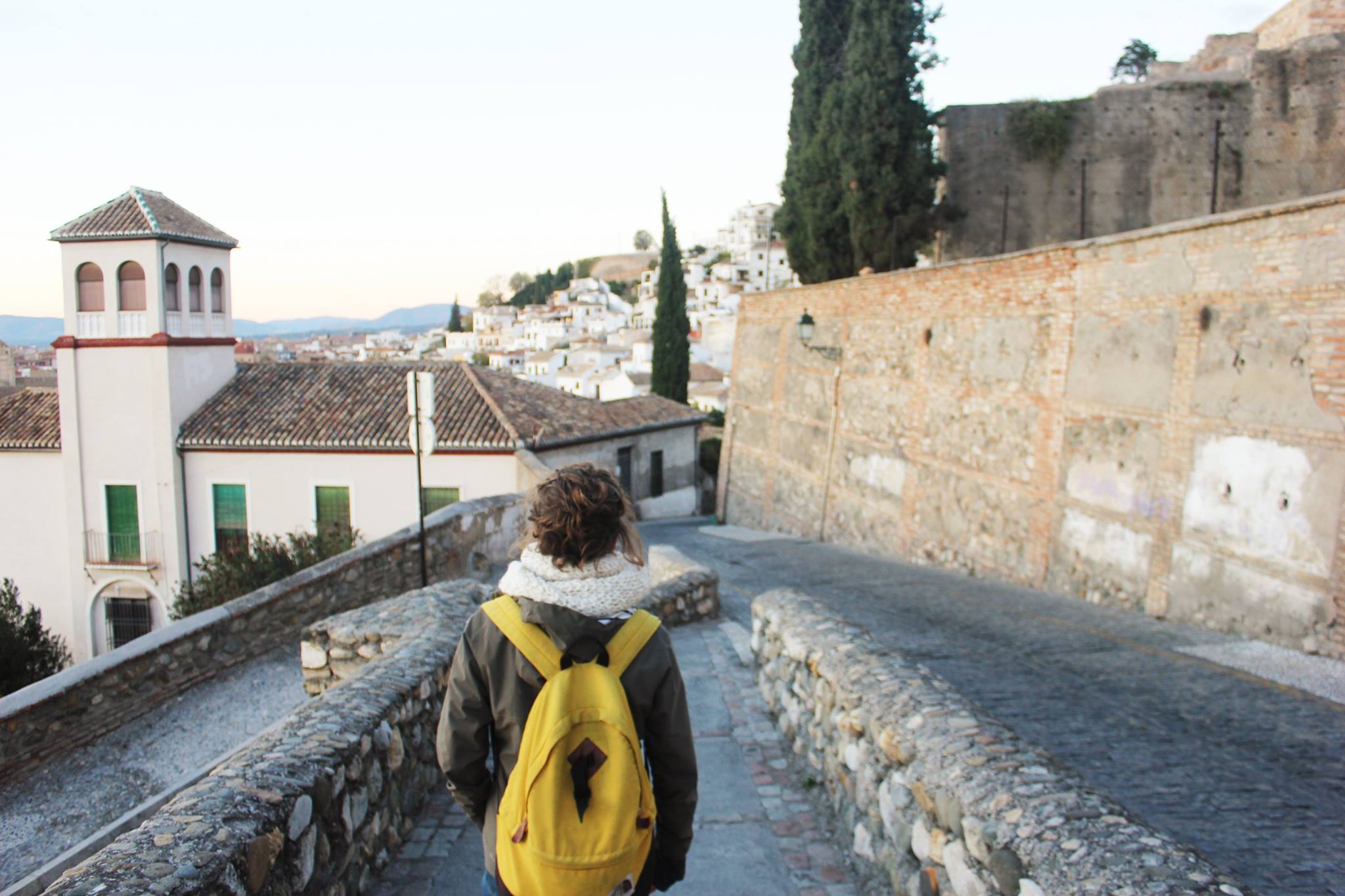
Rushing around famous sights and landmarks, and backpacking to the next destination every few days is exhausting and unsatisfying. We wanted deeper, richer travel experiences. That’s why we embraced slow travel.
What is Slow Travel?
Slow travel is a travel style centred on depth of experience and creating connection to local people and culture. The idea behind slow travel is to immerse yourself fully in the experience of being somewhere foreign, and let go of ‘FOMO’ travel culture.
Slow travel is a conscious decision to travel at your own pace. When you travel slow, you decide not to rush around. You don’t try to chalk up the most countries or cities visited in your 2-week holiday or tick off all of the famous sights. Slow travel focuses on a deeper travel experience of understanding of local culture and lifestyle. You take time to meet local people and experience everyday life in a different country or place.
The slow travel movement is an off-shoot of the slow food movement. The slow food movement was sparked by local Italians protesting against the opening of a McDonald’s in Rome in 1986. They wanted to protect traditional Italian cuisine and culture, and championed slow food over fast food. The slow food movement advocates supporting local farmers, eating local produce and preserving regional dishes.
Slow travel works off the same principles. Slow travel is about connecting with a community and their culture. When you travel slow, you learn about local habits and customs through speaking to locals and ‘living’ in a place. When travelling slow, you open yourself to cultural experiences, learning bits of the local language and enjoying daily activities rather than focusing on trying to get round all the main tourist sights.
Slow travel is inextricably linked to sustainable travel because it focuses on meeting and supporting local people. You opt to get to know the area and support locally-run businesses, restaurants, guesthouses and community projects when you travel slow. Because of this, slow travel is often considered low impact and opposite to mass tourism.
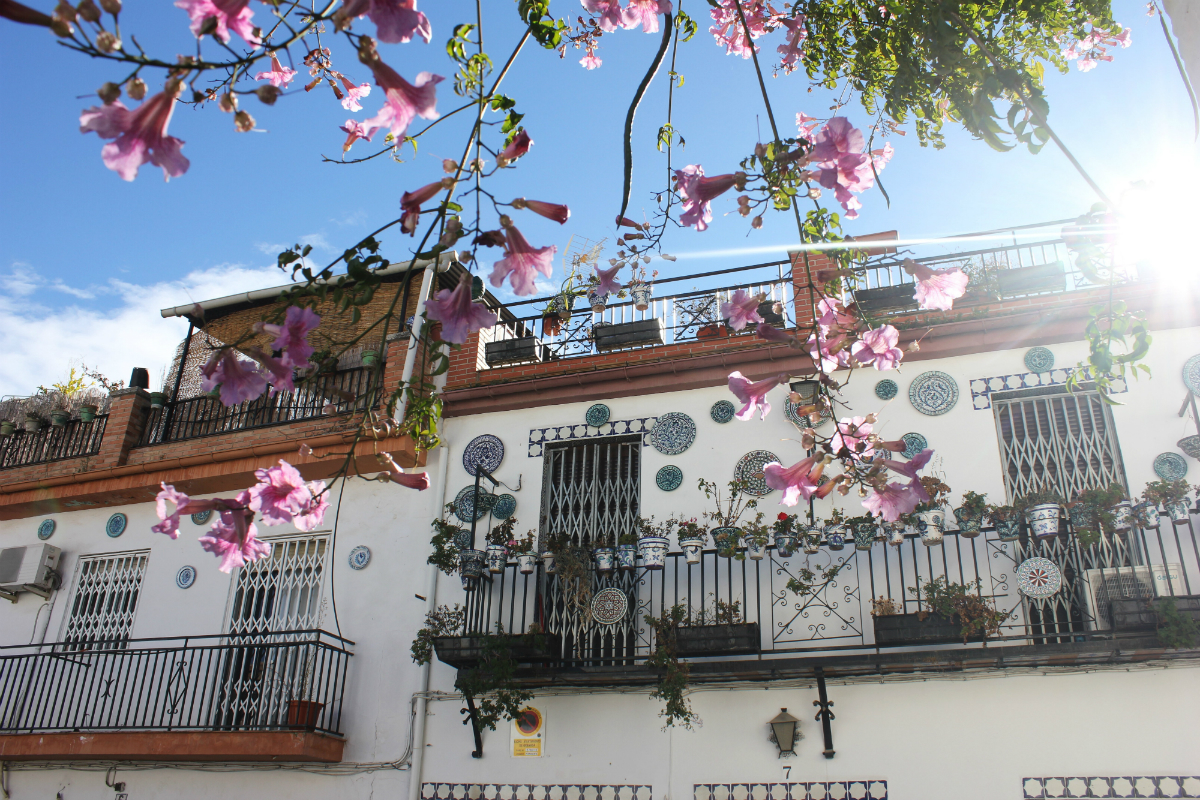
Why We Love Slow Travel
We discovered the concept of slow travel during our first house sitting experience in Costa Rica. We’d planned to travel across Mexico, Central America and down into South America. In the end, we spent almost a year in Costa Rica and we didn’t make it to Mexico or South America. After living in a Costa Rican mountain town, we learned to slow down.
As Costa Ricans say: pura vida. It translates to “simple life” or “pure life” and it means don’t stress, don’t rush, enjoy life and be thankful for what you have. That’s when we decided slow travel was the most meaningful and enjoyable way to travel for us.
How to Travel Slow
There’s no specific set of rules about what slow travel is and how to do it. Slow travel is a personal experience and depends on how you find a connect to a place and people. It’s also not about how long you spend somewhere – though of course if you can travel for longer, then great! It can also be difficult to kick the habit of fast travel, so here are our tips on how to travel slow:
Plan to Visit Fewer Places (or Don’t Plan at All)
Instead of cramming your travel itinerary full and feeling exhausted at the end of your trip, travel slower. Don’t hold yourself accountable for seeing so much. Think about how and where you’d really most like to spend your time. A good way to do this is to choose a good central base and book a guesthouse, Airbnb or villa there for a week or two weeks. You can enjoy local life in the community and still take trips outside of town.
Don’t Worry About Seeing All the Tourist Sights
Let go of that urge to blitz round the tourist attractions and monuments in every city. Taking a quick picture at each sight so you can say ‘been there, done that’ is unlikely to leave you feeling satisfied (more likely you’ll be exhausted!)
Slow travel doesn’t mean avoiding tourist sights altogether either. After all, many tourist sights do hold historical and cultural significance. But it means you can be selective and choose to the sights that interest you most.
Maybe you want to hike mountain trails, relax on the beach or explore local markets in the city instead of seeing the sights, so do that instead.
Give Yourself Freedom and Flexibility
The most important part of slow travel is to give yourself freedom and flexibility. You don’t need to have must-see lists or to-dos for every place you go. Often the best experiences come by chance from wandering around and discovering something or somewhere new. If you want to stroll through a market or pop into a cute coffee shop you stumbled across, then do! You’ll feel much less stressed if you’re not trying to plan every moment.
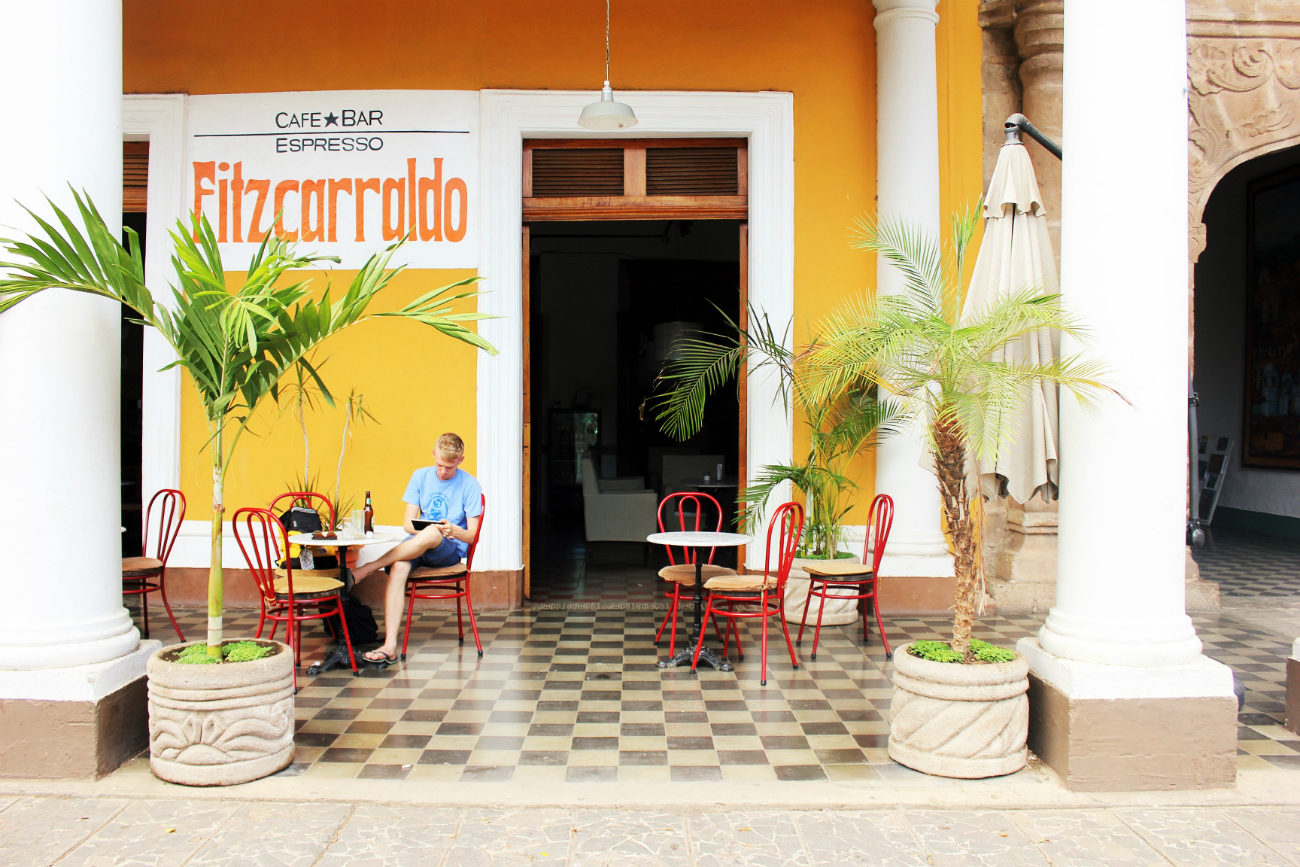
Travel for Longer
Slow travel doesn’t mean you have to take long trips, but if you can then its better. The longer you have in a new place, the more time you have to immerse yourself. If it’s possible to take longer trips then opt for that or if not then try to pack fewer places into your itinerary.
One of our favourite ways to travel for longer has been through house sitting. It means we stay in a home in a local area and usually meet the friends of the people whose home and pets we’re taking care of. Because we’re providing this service, we can keep our travel costs down and stay travelling longer.
Read and Research Beyond the Guidebooks
Whilst guidebooks can be extremely handy, they’re only one way to learn about a place. Use different resources to research your trips. Look for online blogs written by locals, or ask questions in Facebook groups of local people in a city. Use Couchsurfing or Meetup to ask locals questions online or to meet them in-person.
Look for novels, films, music and podcasts about and from the places you’re going and learn that way. We watched these great Vietnam-based films before our trip to Vietnam and it inspired our wanderlust even more! When I went to Vienna, I spent time searching out shooting locations from The Third Man. In Taiwan, we visited Jiufen and were awestruck to see the town the Studio Ghibli film Spirited Away was based on. We’ve also got some recommendation for great Taiwanese films.
For me, I find I have a richer experience in a new place if I’ve read about it or seen scenes in a film before going there. For Luke, he tends to connect on a much deeper level if he understands the history. Before and after our trip to Mexico, he spent 20 hours listening to the Revolutions podcast on the Mexican revolution.
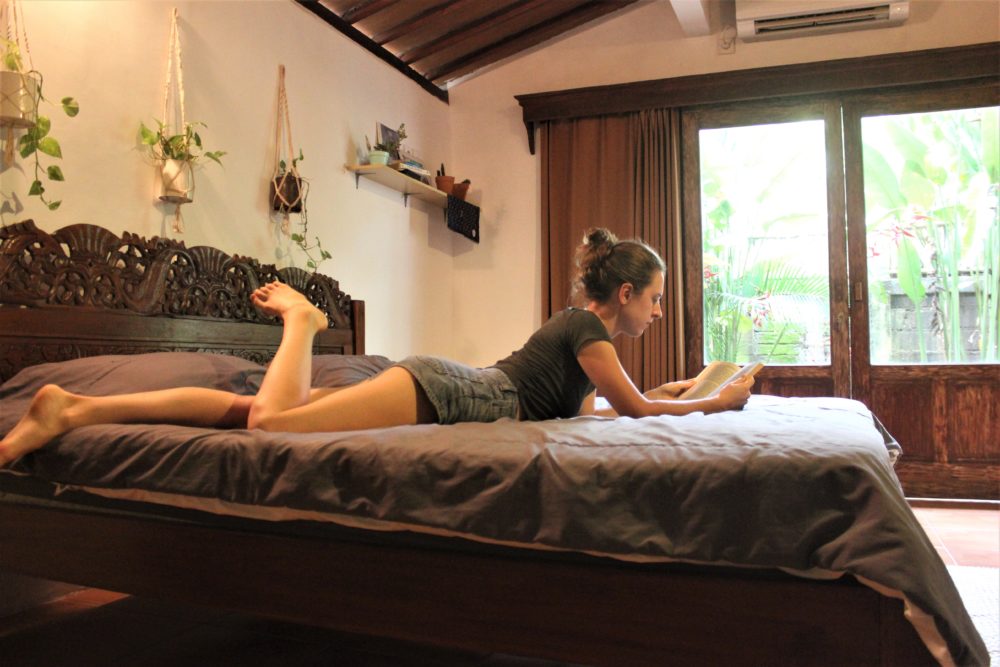
Learn the A Bit of the Language
You don’t have to be the next Benny Lewis, but making an effort to learn a bit of the local language is a good idea. Not only does it mean you can more easily speak and meet locals, but it can give you a deeper understanding of the culture. When we lived in Taiwan, understanding the significance and meaning behind some Chinese words and characters improved our cultural understanding.
Join Local Project and Activities, and Meet Locals
No matter how long you have in a place, you can meet locals through apps and organisations. We use Homestay.com (accommodation with locals), Couchsurfing (accommodation and meetups) and Meetup. We’ve used Couchsurfing to go to pub nights and other group meetups. We’ve found like-minded people through board game meetups and digital marketing workshops).
Search for community projects and volunteering projects in each place you go too. You can do this through community-tourism tour agencies, like Local Alike in Thailand or De La Gente in Guatemala, or just on Google.
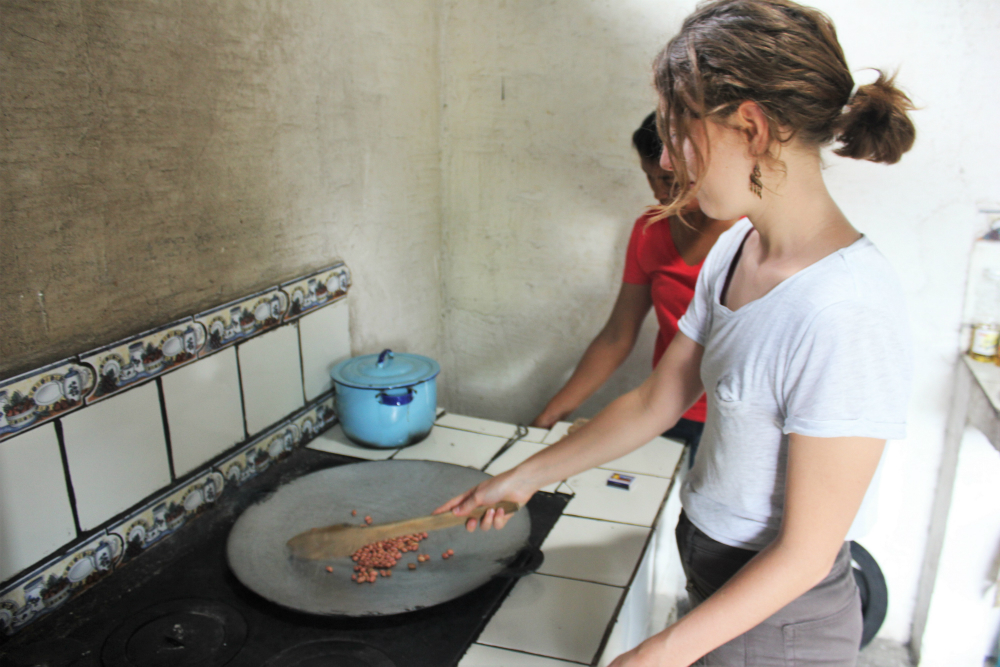
Peanut butter making workshop with De La Gente in Antigua, Guatemala
Eat Local Food and Buy Local Ingredients
Eat what the locals eat. Slow food goes hand-in-hand with slow travel. Look for locally-run restaurants and cafes, and order local specialities. We’re vegetarian and rarely have a problem finding local specialities.
If you’re on a budget or have a dietary requirement, then opt for local ingredients to cook with. We love buying fresh, local produce from markets and learning to cook with new fruits and veggies!
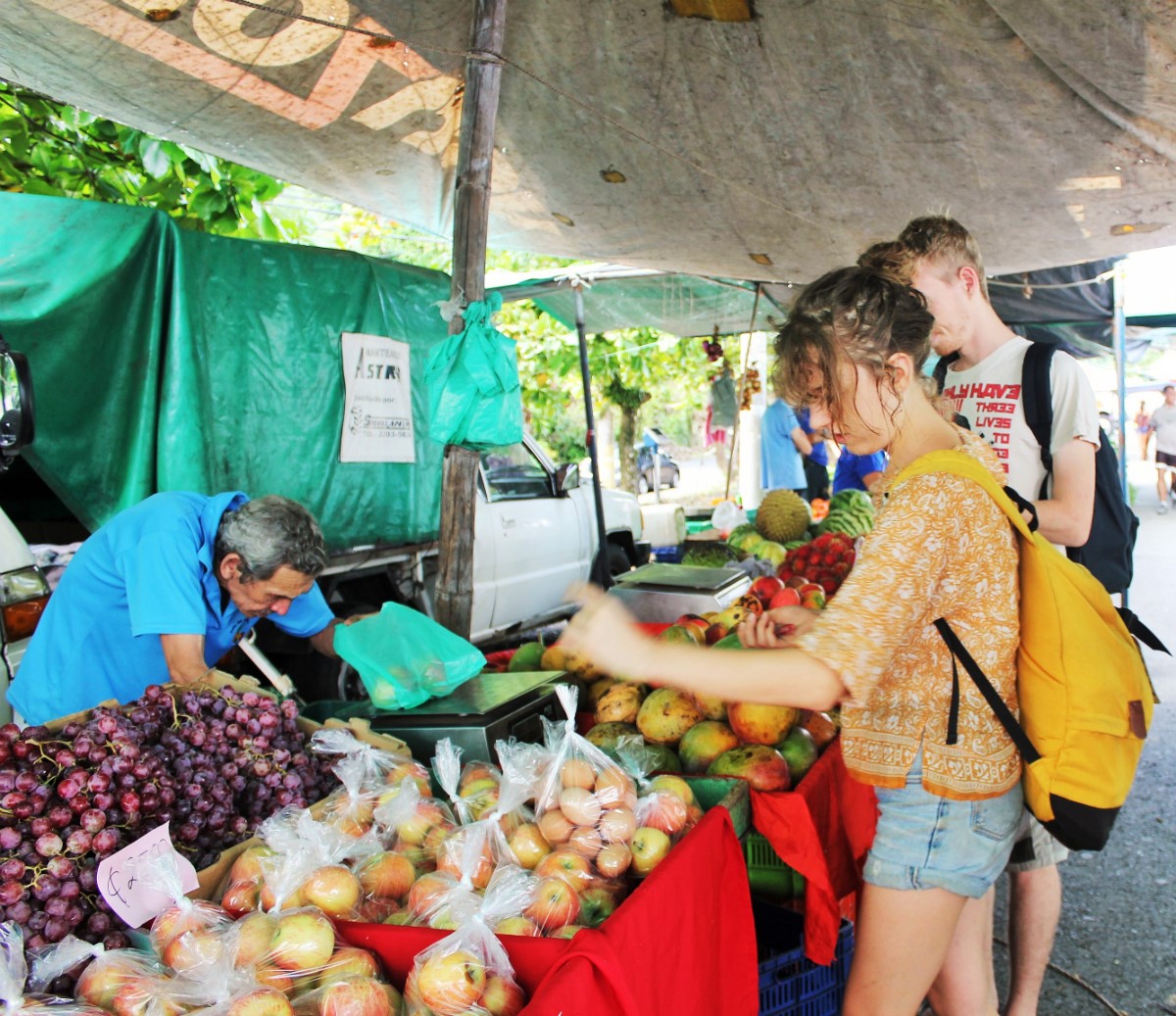
You can buy local produce for cheaper prices than the supermarkets in Costa Rica.
Stay in Local Accommodation
Staying in local accommodation is a good way to meet local people. It also supports the local economy, rather than supporting foreign-owned chain hotels. Here are some slow travel accommodation options:
Couchsurfing – Though it has lost popularity in recent years, we had amazing experiences through Couchsurfing. During a 3-week trip to Poland in 2014, we were generously hosted by Polish people across the country the whole trip. The trip taught us so much more about Polish people, culture and food than we would have learned otherwise.
Homestay – Homestay is a budget accommodation alternative to Airbnb. You can rent private rooms in host’s own homes at very affordable prices. It’s similar to what Airbnb used to be back in the day, and the verified platform with a review function means it’s safer to use and more reliable than Couchsurfing. Perfect for a local experience and a budget-friendly place to stay.
Airbnb – Airbnb used to be how we most frequently found travel accommodation. We’ve had some wonderful Airbnb hosts who made our travels very special, including our host mum in Chetumal pictured below. In recent years, the platform has become increasingly expensive and doesn’t offer the same ‘local’ experience as it used to. We use Airbnb only in cases where we need a private apartment to work from or where there aren’t other viable options.
Booking.com – We sometimes use Booking.com to find apartments and villas abroad, especially in areas where there are lots of accommodation options. The price comparison function is useful for sorting by ‘lowest price first’ to allow you to find affordable options. The main benefit of Booking.com is that it has by far the most accommodation options.
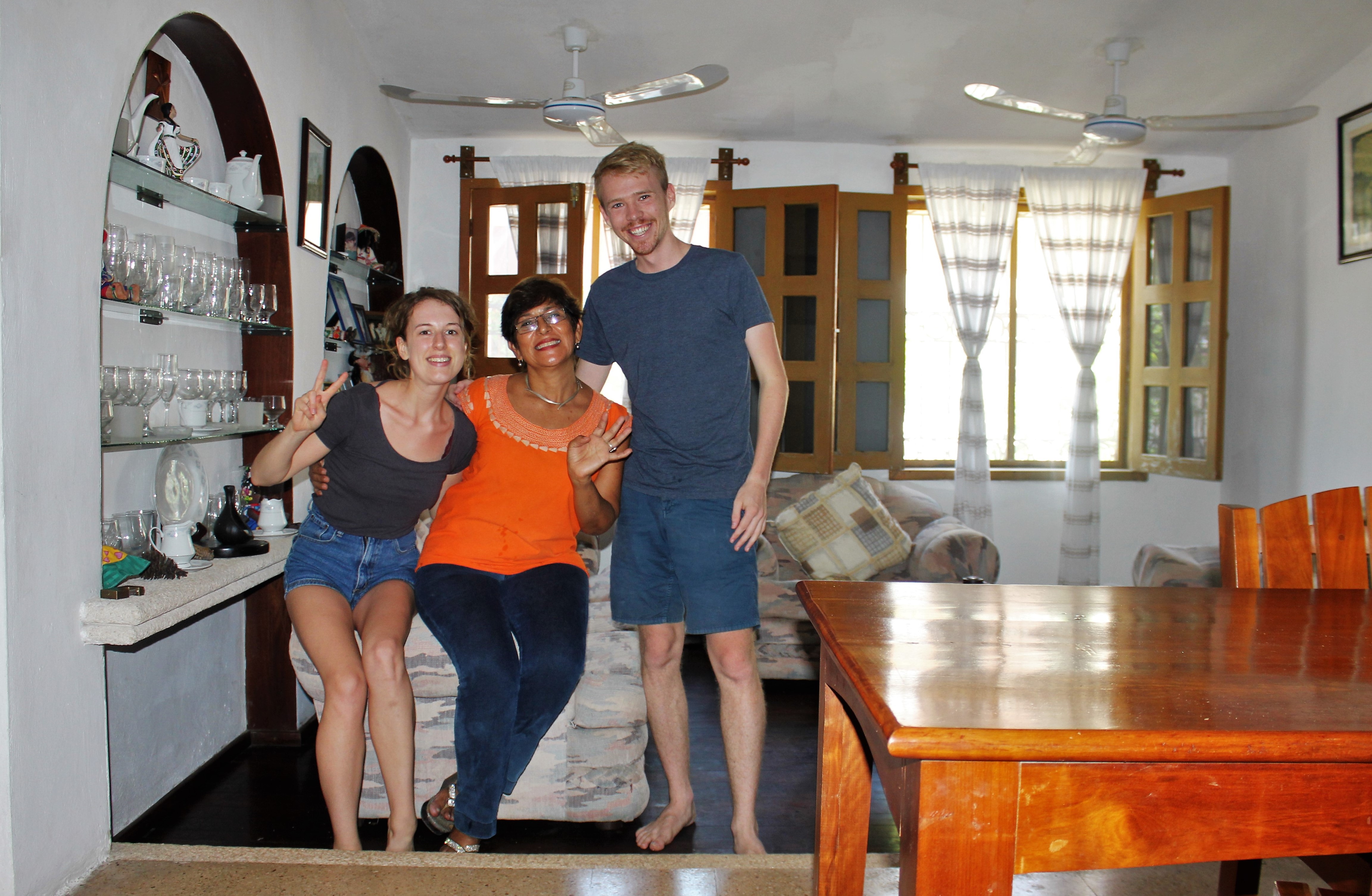
One of our favourite Airbnb hosts. This lady hosted us for 1 week in Chetumal, Mexico. She made us homemade pineapple tea, recommended all the best museums in town and drove us over the border to Belize!
House Sitting – We’ve been house sitters since 2014. We’ve looked after homes and pets in the UK, Mexico, Guatemala, Nicaragua, Costa Rica and Panama. We work online, so house sitting works really well for us because we have a stable wifi connection and home base. House sitting is perfect for slow travel because sits tend to be at least a few weeks long and you’re living in a local community rather than tourist area.
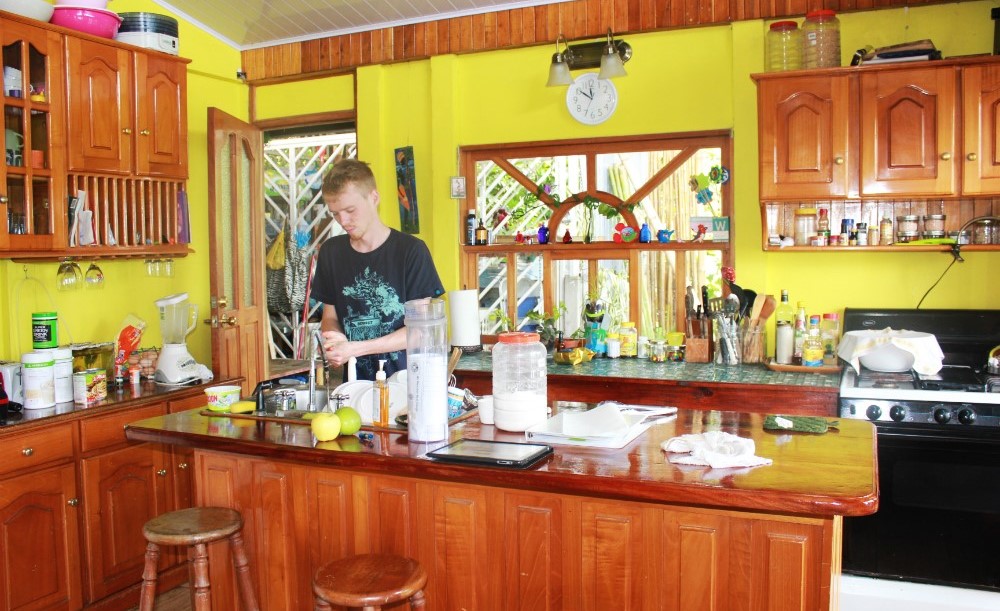
Home Swaps – If you have your own place, then home swaps let you switch houses for a period of time with someone else. This means you don’t incur any accommodation costs and you have a home-away-from-home. Plus you can get local tips from the home owner you switch with!
Guesthouses – Simply search for locally owned guesthouses and BnBs, rather than chain hotels. You’ll have a more authentic travel experience and you’ll be supporting a locally-run business.
Slow Travel Experiences
You can travel slowly anywhere, but some of my favourite slow travel experiences have been during slow travel in Europe. Our slow travel in Barcelona had us staying in the city for 3 weeks. We spent so much time walking, cycling and hiking around the city. We went to the local gym, shopped at the local markets and ate as many tapas as we could get our hands on. Our trip also got us learning to cook tapas with locals through Barcelona Slow Travel.
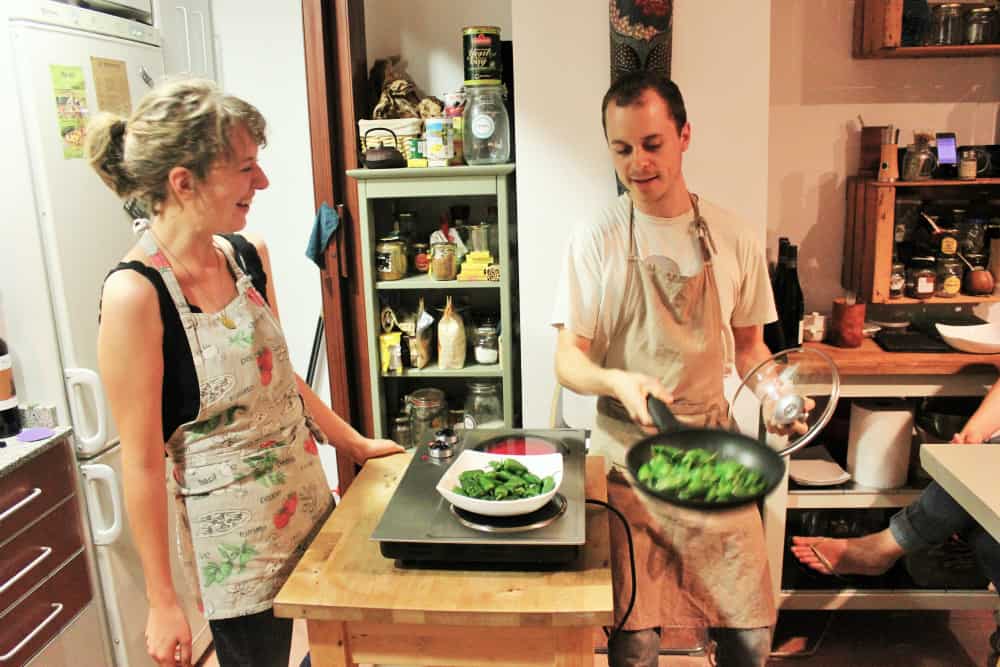
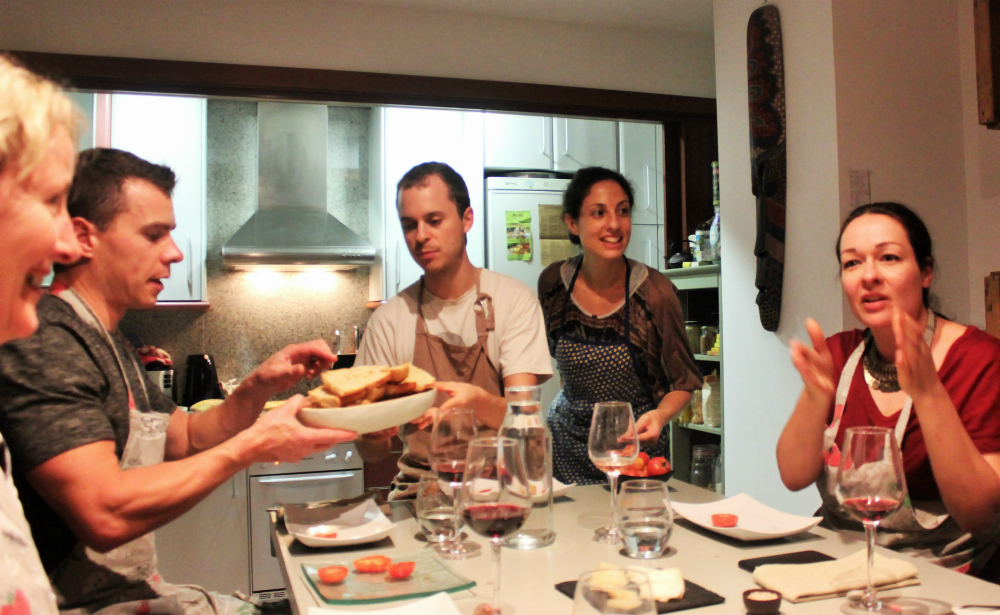
We house sat in Antigua in Guatemala for 3 weeks and got involved with local community projects and social enterprises. We joined a peanut butter making workshop with local peanut farmers. This was organised through community tourism organisation De La Gente.
We visited a water filter factory where we learned about how this social enterprise were contributing to solving water issues in the country by providing clean drinking water for rural communities.
We also spent the day learning about Guatemalan culture with an indigenous family through the charity Small Change 4 Big Change and we’ve been supporters of their work ever since.
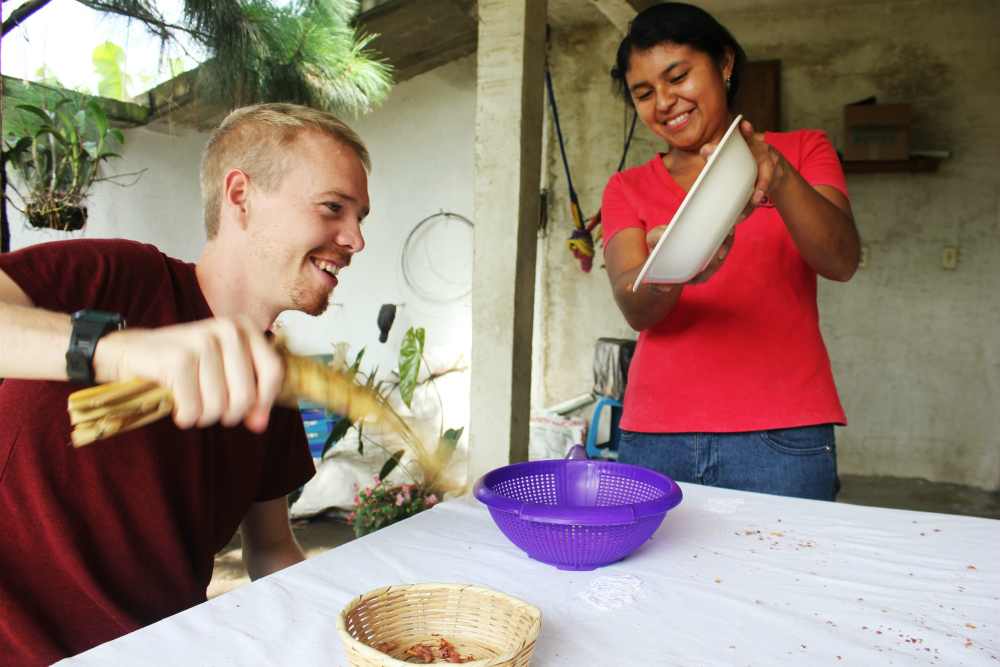
These are just a few example of slow travel experiences. For us, slow travel has been a mindset change. It’s about valuing quality over quantity. The quality of our travel experiences has become richer since we stopped thinking about the number of places, countries or sights we were trying to get to. The important point here is that slow travel can be experienced anywhere.
Slow Travel and the Environment
From an environmental point of view, slow travel is beneficial. Travelling to fewer places means less need to use transport or take flights. If you’re based in just one or a handful of places, you can usually get around by walking, bike or local public transport. Slow travel is also about local experiences. This means you’re choosing not to participate in mass tourism, which comes with negative environmental consequences.
Will Slow Travel Gain Popularity?
I’d like to think slow travel will grow in popularity, but Google trends shows that ‘slow travel’ now has fewer people searching than it did in 2004. Maybe this means that more people are familiar with the concept and have less need to search it out. Perhaps we still have further to go with advocating for travelling slower.
I like to think there are many slow travellers out there who just aren’t aware of the label; they just travel slow naturally. The more of us who become slow travellers and advocate for the slow travel movement by letting others know about how we travel, the better.
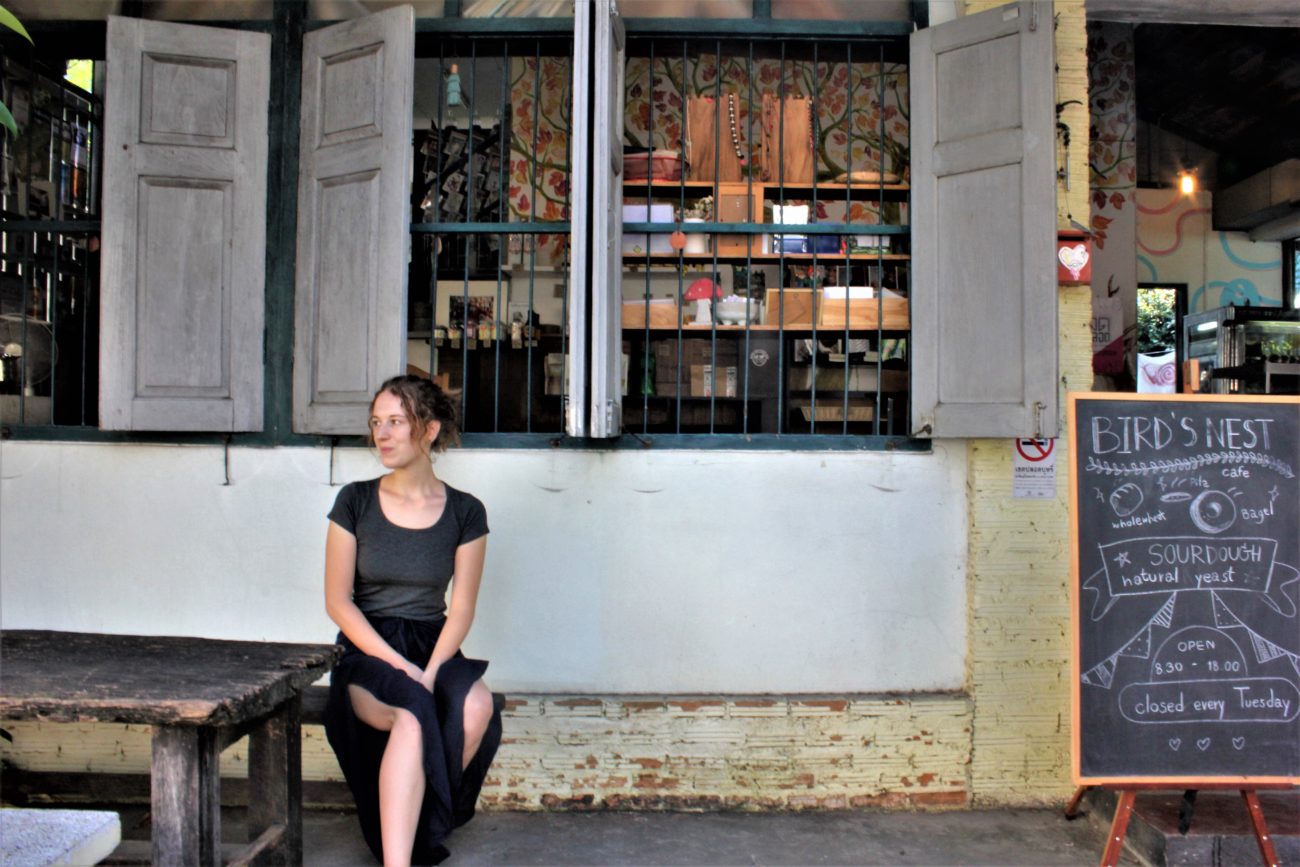
Slow travel feels like a wholesome and satisfying travel experience. There’s no rushing around, no set schedules, no being on edge about missing buses or trains, and so on. You can experience a place at your own pace without the stress of trying to get to see everything and feeling exhausted at your end of the trip. Try it for yourself!


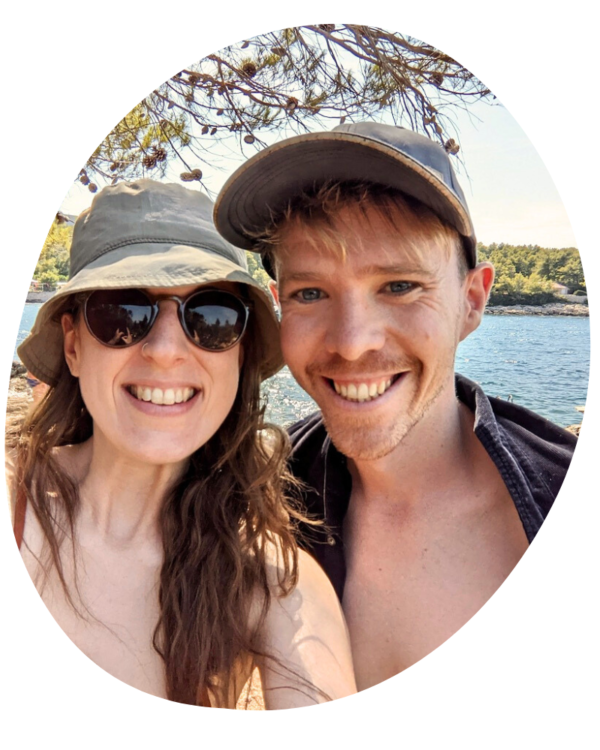


Alberto
Charlie,
I liked reading this article because it perfectly sums up what I had in mind with “slow tour”. It is also stimulating because it offers multiple points of evaluation. I like to travel by boat and sailing, that’s why I found these concepts so familiar. In Tuscany I offer a slow e-bike tour to discover this beautiful region off the beaten track, cycling in nature away from the crowds. If you have any suggestions or are thinking of visiting Italy, please let me know. I’d really like to meet you.
Ciao, Alberto
Charlie Marchant
Hi Alberto – Thank you for your message. We absolutely love cycling, though we have spent very little time on boats or sailing. We’ve not visited Tuscany but have heard wonderful stories of it. I will let you know if we travel that way in the future :)